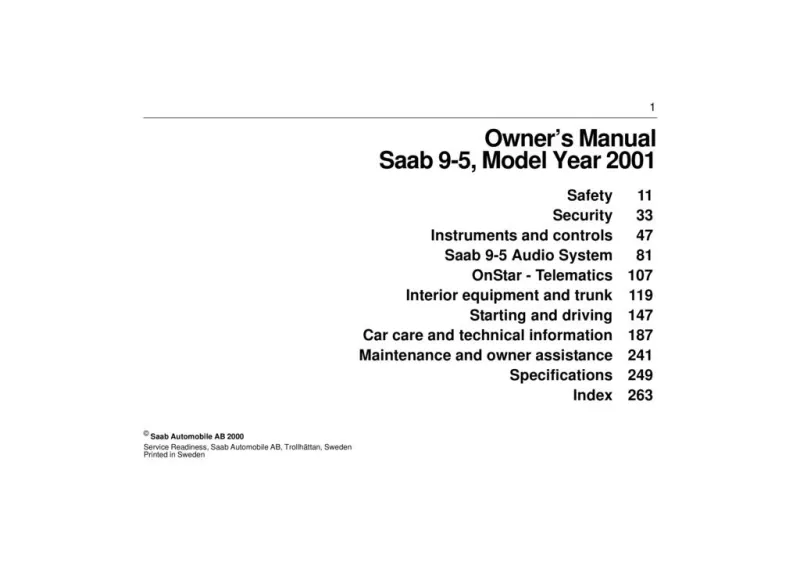Saab 9 5 owners manuals

(owner manual)

(owner manual)

(owner manual)

(owner manual)

(owner manual)

(owner manual)

(owner manual)

Saab 9 5 specs
Owner Manual
The owner manual for the Saab 9-5 is an essential resource for any driver of this iconic vehicle. It provides a comprehensive overview of the car’s features, operating instructions, and maintenance guidelines. This manual covers various aspects such as starting the engine, using the infotainment system, understanding the dashboard indicators, and troubleshooting common issues. It also includes critical safety information, ensuring that drivers can navigate their Saab 9-5 with confidence and care. By familiarizing yourself with the contents of the owner manual, you can enhance your driving experience and ensure that your vehicle operates smoothly.
Model Overview
The Saab 9-5 is a premium midsize sedan that blends performance, safety, and luxury. Initially launched in 1997 with a second-generation model introduced in 2010, the 9-5 was known for its distinctive design and innovative engineering. Utilizing a front-wheel-drive layout, it delivered a smooth ride and excellent handling characteristics. The vehicle was powered by a variety of engines, including turbocharged options that provided both power and efficiency. The 9-5 was appreciated for its roomy interior, high-quality materials, and advanced technology, making it a favorite among driving enthusiasts and families alike.
Trims
The Saab 9-5 offered several trims across its production years, catering to a wide range of preferences and needs. Key trims included the Linear, Arc, and Aero versions. The Linear trim generally featured a solid list of standard equipment and a comfortable yet functional interior. The Arc model added more luxury features, such as leather upholstery, premium audio systems, and advanced climate control. The Aero trim stood out with sportier performance attributes, upgraded suspension, and a more powerful engine, appealing to those seeking a thrilling driving experience. Each trim level offered unique combinations of style and capability, allowing buyers to select their ideal configuration.
Known Problems
While the Saab 9-5 is celebrated for its reliability, certain issues have been reported over the years. Common problems include electrical gremlins, such as malfunctioning window regulators and erratic dash display indicators. Additionally, some owners have experienced engine-related issues, particularly with turbochargers in earlier models. Suspension components may also wear out over time, leading to uneven tire wear and handling concerns. It’s crucial for owners to stay vigilant and address these concerns promptly to maintain the car's performance and longevity.
Maintenance Tips
Regular maintenance is key to keeping your Saab 9-5 in excellent condition. Adhering to a strict maintenance schedule as per the owner manual is vital. This includes timely oil changes, which safeguard engine performance and longevity. Check and replace air and cabin filters routinely to ensure optimal air quality and engine efficiency. Inspect brake pads and rotors regularly, as well as suspension components, to keep the car safe and responsive. It’s also advisable to use OEM parts for repairs to maintain the vehicle's integrity. Lastly, don’t neglect tire health; ensure proper inflation and rotation to prolong tire life.
FAQs
What type of fuel does the Saab 9-5 require?
The Saab 9-5 typically requires premium unleaded gasoline, especially for turbocharged models, to ensure optimal performance.
How often should I perform oil changes?
Oil change intervals may vary, but it is generally recommended to change the oil every 5,000 to 7,500 miles, or as indicated in the owner manual.
Are there any special features to look for in the 9-5?
Look for features like heated seats, advanced audio systems, and navigation capabilities that enhance comfort and convenience.
Is the Saab 9-5 considered a safe vehicle?
Yes, the Saab 9-5 has received high safety ratings, with features such as high-strength steel construction, multiple airbags, and advanced braking systems.
Saab 9 5 PDF owner manual
Saab 9 5 competitors
Saab 9 5 Manual Questions
Fill the form below and someone will help you!





